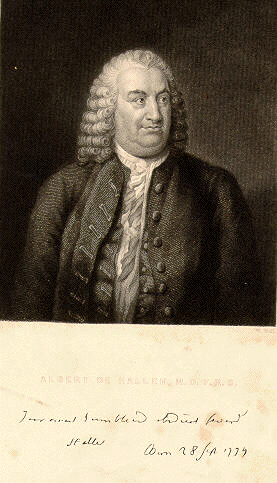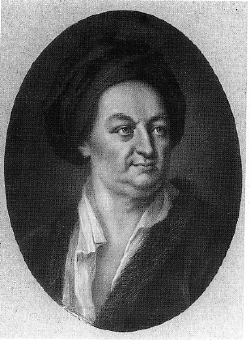- Les
biographies de
neurologues
-
- Born in Bern, Switzerland, Albrecht von
Haller was educated at the University of
Tübingen and at the University of Leyden,
where he studied under Boerhaave and Albinus. In
1735, after practicing medicine for eight years
in Bern, Haller accepted the position as chair
of medicine, anatomy, surgery, and botany at the
University of Göttingen. He remained at
Göttingen for seventeen years, then
returned to Switzerland to spend the rest of his
life in research and writing.
-
- Haller, called "the Great"even in his
lifetime, was an illustrious scholar and
prolific writer whose interests included poetry,
botany, ancient languages, biography, and
philosophy, as well as medicine. His primary
claims to fame are in medical bibliography and
physiology. Haller compiled twenty volumes of
bibliographies on anatomy, botany, surgery, and
medicine. As physiologist, he proved the concept
of "irritability"of tissue, distinguishing
between nerve impulse (sensibility) and muscular
contraction (irritability). In 1747, he
published his observations in Primae Lineae
Physiologiae (First Lines of
Physiology).
-
 -
- The first comprehensive treatise of
physiology, with much of the information coming
directly from research work done by Haller
himself, mostly conducted at Göttingen.
"This massive work, containing structural,
physiological and chemical analyses of every
part of the body, constituted Haller's most
important contribution to the development of
physiology. It included his work on muscle
irritability, nutrition, reproduction, the
circulatory system, respiration, excretion and
secretion, and psychobiology, with all reported
theories and experiments supported by copious
notes and references. Haller reported several
physiologiocal discoveries in this work that
were later forgotten, to be rediscovered only
many years later; among these were his myogenic
theory of the heartbeat and the role of bile in
the digestion of fats."
-
- Haller synthesized the whole physiological
knowledge of his time. In the above, probably
his greatest work, Haller included some
anatomical descriptions which were most
valuable. He is said to have written more than
1300 scientific papers.
-
- "Although Haller had many interests and
talents, he was chiefly a physiologist, and one
of his great contributions to physiology was his
demonstration that irritability is a specific
property of all muscle tissue and that
sensibility is the exclusive property of nervous
tissue. This work, first published in 1747,
contains many of the ideas that Haller later
developed more fully in elementa physiologiae
corporis humani, including his resonance theory,
similar to that already advanced by Duverney and
to that of Helmholtz more than one hundred years
later."
-
 
|






